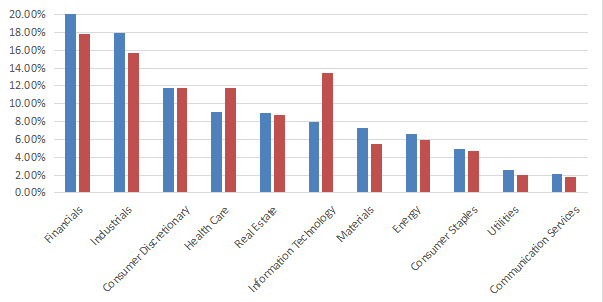syahrir maulana/iStock via Getty Images
SLYV Strategy And Portfolio
The SPDR S&P 600 Small Cap Value ETF (NYSEARCA:SLYV) has been tracking the S&P SmallCap 600 Value Index since September 2000. It has a large portfolio of over 400 holdings, an expense ratio of 0.15% and a distribution yield of 1.65%.
As described in the prospectus by S&P Dow Jones Indices, S&P 600 constituents are ranked in Value and Growth styles using three valuation ratios and three growth metrics. The valuation ratios are book value to price, earnings to price and sales to price. By construction, 33% of S&P 600 constituents exclusively belongs to each style, and 34% belongs to both styles. The Value subset serves as S&P 600 Value Index and is rebalanced annually. It is capital-weighted, with an adjustment for constituents belonging to both styles. For example, a company with a Value rank better than its Growth rank is given a larger weight in the Value Index than in the Growth Index.
SLYV invests almost exclusively in U.S. companies (99.4% of asset value). As expected, SLYV is cheaper than its parent index S&P SmallCap 600 (IJR) regarding usual valuation ratios (reported in the next table).
|
SLYV |
IJR |
|
|
Price/Earnings TTM |
13.55 |
14.25 |
|
Price/Book |
1.51 |
1.92 |
|
Price/Sales |
0.81 |
1.07 |
|
Price/Cash Flow |
9.62 |
10.67 |
The top 10 holdings, listed below with valuation ratios, represent less than 7% of asset value and the heaviest position weights less than 1%: the fund is well diversified and the risk related to individual stocks is very low.
|
Ticker |
Name |
Weight (%) |
P/E TTM |
P/E fwd |
P/Sales TTM |
P/Book |
P/Net Free Cash Flow |
Yield% |
|
(HP) |
Helmerich & Payne Inc. |
0.92 |
N/A |
N/A |
3.53 |
1.75 |
N/A |
2.21 |
|
(SJI) |
South Jersey Industries Inc. |
0.76 |
20.93 |
20.59 |
2.04 |
2.03 |
N/A |
3.60 |
|
(BKU) |
BankUnited Inc. |
0.72 |
9.30 |
11.85 |
3.35 |
1.21 |
13.99 |
2.37 |
|
(NSIT) |
Insight Enterprises Inc. |
0.70 |
16.89 |
12.93 |
0.39 |
2.45 |
33.18 |
0 |
|
(FHB) |
First Hawaiian Inc. |
0.69 |
13.47 |
15.46 |
4.81 |
1.34 |
14.23 |
3.77 |
|
(AVA) |
Avista Corp. |
0.64 |
21.90 |
22.76 |
2.28 |
1.52 |
N/A |
3.83 |
|
(PTEN) |
Patterson-UTI Energy Inc. |
0.64 |
N/A |
N/A |
2.58 |
2.17 |
N/A |
0.98 |
|
(TWNK) |
Hostess Brands Inc. |
0.62 |
26.26 |
23.71 |
2.75 |
1.83 |
22.81 |
0 |
|
(REZI) |
Resideo Technologies Inc. |
0.61 |
13.16 |
10.72 |
0.55 |
1.42 |
12.66 |
0 |
|
(COOP) |
Mr. Cooper Group Inc. |
0.61 |
2.51 |
7.46 |
1.08 |
0.93 |
1.87 |
0 |
The heaviest sectors are financials (20.2%) and industrials (18%). Other sectors are below 12%. Compared to the S&P 600, the fund overweights these top two sectors and also materials. It underweights technology and healthcare. The difference in other sector weights is not very significant.
Sectors: SLV (in blue) vs. IJR (red) (chart: author; data: Fidelity)
Since inception in September 2000, the difference between SLYV and IJR in return and risk metrics is not significant: only 9 bps in annualized return, 1.6 percentage points in maximum drawdown and 8 bps in volatility (standard deviation of monthly returns). Risk adjusted performance measured by Sharpe ratios is identical.
|
Total Return |
Annual Return |
Drawdown |
Sharpe ratio |
Volatility |
|
|
SLYV |
621.48% |
9.62% |
-61.35% |
0.52 |
19.98% |
|
IJR |
634.79% |
9.71% |
-59.77% |
0.52 |
19.80% |
Comparing SLYV With My Value Benchmark
The Dashboard List is a list of 80 stocks in the S&P 1500 index (occasionally less), updated every month based on a simple quantitative methodology. All stocks in the Dashboard List are cheaper than their respective industry median in Price/Earnings, Price/Sales and Price/Free Cash Flow. An exception in Utilities: the Price/Free Cash Flow is not taken into account to avoid some inconsistencies. After this filter, the 10 companies with the highest Return on Equity in every sector are kept in the list. Some sectors are grouped together: Energy with Materials, Telecom with Technology. Real Estate is excluded because these valuation metrics don’t work well in this sector. I have been updating the Dashboard List every month on Seeking Alpha since December 2015, first in free-access articles, then in Quantitative Risk & Value.
The next table compares SLYV performance since inception with the Dashboard List model, with a tweak: here the list is reconstituted once a year to make it comparable with a passive index.
|
Total Return |
Annual Return |
Drawdown |
Sharpe ratio |
Volatility |
|
|
SLYV |
621.48% |
9.62% |
-61.35% |
0.52 |
19.98% |
|
Dashboard List (annual) |
1141.90% |
12.42% |
-56.85% |
0.7 |
17.13% |
Past performance is not a guarantee of future returns. Data Source: Portfolio123
The Dashboard List beats SLYV by 2.8 percentage points in annualized return and shows a lower risk in drawdown and volatility. A note of caution: the ETF performance is real and the list is simulated.
SLYV Fundamental Shortcomings
SLYV underlying index has two shortcomings in my opinion. The first and largest one is to classify all stocks on the same criteria. It means the valuation ratios are considered comparable across sectors. Obviously, they are not: you can read my monthly dashboard here for more details about this topic. A consequence is to privilege sectors where valuation ratios are naturally cheaper, especially financials. Sectors with large intangible assets like technology are disadvantaged. To make things simple, companies with large intangible assets are those with a business model based on massive R&D, or a strong branding, or large user databases, or operating in a field where competition is limited by an expensive entry ticket. All these elements are not correctly reflected by valuation ratios.
The second flaw is using the price/book ratio (P/B), which adds some risk in the strategy. Intuitively, we can guess a large group of companies with low P/B contains a higher percentage of value traps than a same-size group with low price/earnings, price/sales or price/free cash flow. Statistically, such a group will also have a higher volatility and deeper drawdowns in price. The next table shows the return and risk metrics of the cheapest quarter of the S&P 500 (i.e.125 stocks) measured in price/book, price/earnings, price/sales and price/free cash flow. The sets are reconstituted annually between 1/1/1999 and 1/1/2022 with elements in equal weight.
|
Annual Return |
Drawdown |
Sharpe ratio |
Volatility |
|
|
Cheapest quarter in P/B |
9.95% |
-72.36% |
0.48 |
21.05% |
|
Cheapest quarter in P/E |
11.25% |
-65.09% |
0.57 |
18.91% |
|
Cheapest quarter in P/S |
12.62% |
-65.66% |
0.6 |
20.46% |
|
Cheapest quarter in P/FCF |
12.23% |
-63.55% |
0.61 |
19.05% |
Data calculated with Portfolio123
This explains my choice of using P/FCF and not P/B in the Dashboard List model.
Takeaway
SLYV tracks a small cap value index based on systematic rules using three valuation metrics. It has a large, diversified portfolio of over 400 holdings. No stock weighs more than 1% and the heaviest sector, financials, represent 20% of asset value, which is acceptable. The expense ratio is reasonable and it is not riskier than the parent index S&P 600 regarding drawdowns and volatility. SLYV failed to beat the S&P 600 benchmark in two decades, which casts doubt on the concept of value implemented by the fund. I think there are two shortcomings in it: it ranks stocks regardless of their sectors, and the price/book ratio is a questionable metric. An efficient value model should compare stocks in comparable sets (sector, industry), like I do in the Dashboard List since 2015. My model prefers price/sales to price/book. Moreover, a simple profitability rule helps filter out some value traps and fix the number of holdings.


Be the first to comment